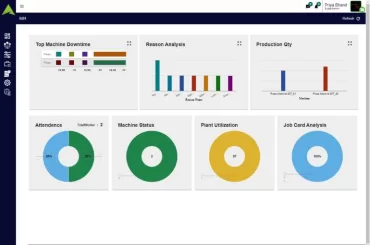Business intelligence (BI) refers to the technologies, processes, and practices that organisations use to collect, integrate, analyse, and present data in order to make better-informed business decisions. BI helps organisations gain insights into their internal, and external trends, which can then be used to identify opportunities, optimise performance, and drive growth.
The goal of business intelligence is to provide decision-makers with the information and insights they need to make more informed and strategic decisions, ultimately leading to improved business performance and competitiveness.
Manufacturing Intelligence (MI) is a specific application of BI to the manufacturing industry. In other words, MI is a subset of BI that is focused on collecting and analysing data generated by manufacturing operations. BI encompasses a wide range of activities, including data mining, data warehousing, data analysis, reporting, and visualisation.
MI enables enterprises to gather and analyse real-time data from their operations, identify inefficiencies and opportunities for improvement, optimise production processes, and improve product quality.
The relationship between BI and MI is that MI is a specialised form of BI that is tailored to the needs and challenges of the manufacturing industry. Using BI technologies and practices on manufacturing data, MI helps manufacturers make data-driven decisions that can lead to improved operational efficiency, product quality, and competitiveness in the market.
Manufacturing Intelligence (MI) is the use of real time sensor data, data analytics and business intelligence techniques to improve manufacturing processes, optimise operations, and enhance overall performance. MI can play a critical role in building intelligence by providing valuable data and insights from the manufacturing process that can improve overall business strategy.
Here are some ways that Manufacturing Intelligence can help build Business Resilience:
Improved data collection: MI can collect data from a variety of sources, including sensors, machines, and software systems, providing a wealth of data that can be used for BI. This data can be used to identify patterns, trends, and opportunities for improvement in manufacturing processes, as well as insights into customer behaviour, market trends, and other business factors.
Real-time monitoring: Real-time monitoring of manufacturing processes, people, machines, enabling manufacturers to quickly identify and respond to issues that arise. This data can be integrated with other BI tools to provide a comprehensive view of overall business performance.
Predictive analytics: Get actionable data from machines or various industrial assets to forecast future trends and outcomes, potential opportunities and threats to the business.
Operational efficiency: MI helps improve operational efficiency by identifying areas of the manufacturing process that can be optimised, resulting in cost savings and improved productivity. This data can be used to inform overall business strategy, enabling companies to make data-driven decisions that improve performance.
MI can help enterprises improve overall business efficiency, strategy, and build a strong foundation for Business Resilience. Real-time and valuable data in MI is generated by the sensors and edge devices connected to various shop floor data points on different assets, which are a part of the Internet Of Things(IOT) layer of the solution.
The Internet of Things (IoT) can play a crucial role in Manufacturing Intelligence (MI) by providing real-time data from various sources within the manufacturing environment. IoT sensors can be embedded in machines, tools, and equipment to collect data on their performance, such as temperature, pressure, speed, and vibration. This data can then be analyzed using MI tools and technologies to gain insights into machine health, efficiency, and maintenance needs.
In addition to machine-level data, IoT sensors can also collect data on the movement and location of goods and materials throughout the manufacturing process. This information can be used to optimize inventory management, reduce waste and delays, and improve supply chain visibility.
Overall, IoT can help manufacturers gain greater visibility into their operations, improve their ability to monitor and control production processes, and make data-driven decisions that can improve efficiency, reduce costs, and enhance product quality. By leveraging MI and IoT technologies together, manufacturers can gain a competitive advantage by optimizing their operations and delivering products more quickly and efficiently thus helping Enterprises build Business Intelligence.
Conclusion
Real-time monitoring made possible by IoT-based asset tracking improves the operational effectiveness of Businesses. Additionally, it makes it easier to create business models for monitoring asset performance over the course of the asset’s life cycle. Every business will need a different asset management plan. Our Asset Intelligence Platform is flexible and can be used for a wide range of purposes across various manufacturing process.
If you are interested in knowing how our Senskon-based Asset Management can help track KPIs during the processes and achieve your sustainability goals, feel free to talk to us and we will walk you through how our Asset Intelligence solution works and how it can help you achieve your productivity targets and reduce your carbon footprint considerably.
Inteliiot is a tech-enabled company that unleashes the power of IoT to help you improve your business using various services. By helping our customers create more goods and services while using fewer resources, we at Inteliiot are contributing towards building leaner and more responsible supply chains.





